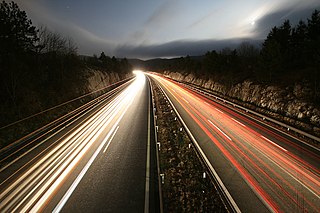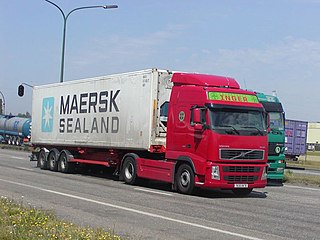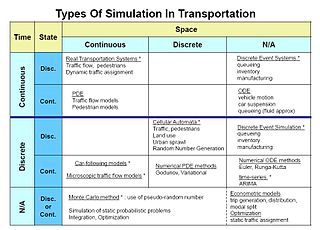Related Research Articles
The vast majority of passenger travel in the United States occurs by automobile for shorter distances and airplane or railroad for longer distances. Most cargo in the U.S. is transported by, in descending order, railroad, truck, pipeline, or boat; air shipping is typically used only for perishables and premium express shipments. Transportation is the largest source of greenhouse gas emissions in the United States.

Road transport or road transportation is a type of transport using roads. Transport on roads can be roughly grouped into the transportation of goods and transportation of people. In many countries licensing requirements and safety regulations ensure a separation of the two industries. Movement along roads may be by bike, automobile, bus, truck, or by animal such as horse or oxen. Standard networks of roads were adopted by Romans, Persians, Aztec, and other early empires, and may be regarded as a feature of empires. Cargo may be transported by trucking companies, while passengers may be transported via mass transit. Commonly defined features of modern roads include defined lanes and signage. Various classes of road exist, from two-lane local roads with at-grade intersections to controlled-access highways with all cross traffic grade-separated.

Transportation engineering or transport engineering is the application of technology and scientific principles to the planning, functional design, operation and management of facilities for any mode of transportation in order to provide for the safe, efficient, rapid, comfortable, convenient, economical, and environmentally compatible movement of people and goods transport.

Transportation planning is the process of defining future policies, goals, investments, and spatial planning designs to prepare for future needs to move people and goods to destinations. As practiced today, it is a collaborative process that incorporates the input of many stakeholders including various government agencies, the public and private businesses. Transportation planners apply a multi-modal and/or comprehensive approach to analyzing the wide range of alternatives and impacts on the transportation system to influence beneficial outcomes.

Logistics is the part of supply chain management that deals with the efficient forward and reverse flow of goods, services, and related information from the point of origin to the point of consumption according to the needs of customers. Logistics management is a component that holds the supply chain together. The resources managed in logistics may include tangible goods such as materials, equipment, and supplies, as well as food and other consumable items.

Traffic congestion is a condition in transport that is characterized by slower speeds, longer trip times, and increased vehicular queueing. Traffic congestion on urban road networks has increased substantially since the 1950s. When traffic demand is great enough that the interaction between vehicles slows the traffic stream, this results in congestion. While congestion is a possibility for any mode of transportation, this article will focus on automobile congestion on public roads.

A warehouse is a building for storing goods. Warehouses are used by manufacturers, importers, exporters, wholesalers, transport businesses, customs, etc. They are usually large plain buildings in industrial parks on the outskirts of cities, towns, or villages.

A distribution center for a set of products is a warehouse or other specialized building, often with refrigeration or air conditioning, which is stocked with products (goods) to be redistributed to retailers, to wholesalers, or directly to consumers. A distribution center is a principal part, the order processing element, of the entire order fulfillment process. Distribution centers are usually thought of as being demand driven. A distribution center can also be called a warehouse, a DC, a fulfillment center, a cross-dock facility, a bulk break center, and a package handling center. The name by which the distribution center is known is commonly based on the purpose of the operation. For example, a "retail distribution center" normally distributes goods to retail stores, an "order fulfillment center" commonly distributes goods directly to consumers, and a cross-dock facility stores little or no product but distributes goods to other destinations.

Rail freight transport is the use of railways and trains to transport cargo as opposed to human passengers.
Truckload shipping is the movement of large amounts of homogeneous cargo, generally the amount necessary to fill an entire semi-trailer or intermodal container. A truckload carrier is a trucking company that generally contracts an entire trailer-load to a single customer. This is as opposed to a less-than truckload (LTL) company that generally mixes freight from several customers in each trailer. One advantage Full Truckload (FTL) carriers have over Less than Truckload carriers is that the freight is never handled en route, whereas an LTL shipment will typically be transported on several different trailers. Truckload shipments are typically run on 48' or 53'dry van trailers which will hold 24 or 26 pallets respectively.

Cold chain is a set of rules and procedures that ensure the systematic coordination of activities for ensuring temperature-control of goods while in storage and transit. The objective of a cold chain is to preserve the integrity and quality of goods such as pharmaceutical products or perishable good from production to consumption. Cold chain management earned its name as a "chain" because it involves linking a set of storage locations and special transport equipment, required for ensuring that temperature conditions for goods are met, while they are in storage or in transit from production to consumption, akin to the interconnected links of a physical chain.

Transportation demand management or travel demand management (TDM) is the application of strategies and policies to increase the efficiency of transportation systems, that reduce travel demand, or to redistribute this demand in space or in time.

A refrigerated container or reefer is an intermodal container used in intermodal freight transport that is capable of refrigeration for the transportation of temperature-sensitive, perishable cargo such as fruits, vegetables, meat, and other similar items.

Land transport is the transport or movement of people, animals or goods from one location to another location on land. This is in contrast with other main types of transport such as maritime transport and aviation. The two main forms of land transport can be considered to be rail transport and road transport.
A specialized set of jargon describe the tools, equipment, and employment sectors used in the trucking industry in the United States. Some terms may be used within other English-speaking countries, or within the freight industry in general. For example, shore power is a term borrowed from shipping terminology, in which electrical power is transferred from shore to ship, instead of the ship relying upon idling its engines. Drawing power from land lines is more efficient than engine idling and eliminates localized air pollution. Another borrowed term is "landing gear", which refers to the legs which support the front end of a semi-trailer when it is not connected to a semi-truck. Some nicknames are obvious wordplay, such as "portable parking lot", in reference to a truck that carries automobiles.

The American Trucking Associations (ATA), founded in 1933, is the largest national trade association for the trucking industry. ATA represents more than 37,000 members covering every type of motor carrier in the United States through a federation of other trucking groups, industry-related conferences, and its 50 affiliated state trucking associations. Former Governor of Kansas Bill Graves was replaced by Chris Spear as the ATA's president and CEO in July 2016.
Transport or transportation is the intentional movement of humans, animals, and goods from one location to another. Modes of transport include air, land, water, cable, pipelines, and space. The field can be divided into infrastructure, vehicles, and operations. Transport enables human trade, which is essential for the development of civilizations.

Traffic simulation or the simulation of transportation systems is the mathematical modeling of transportation systems through the application of computer software to better help plan, design, and operate transportation systems. Simulation of transportation systems started in the 1950s, and is an important area of discipline in traffic engineering and transportation planning today. Various national and local transportation agencies, academic institutions and consulting firms use simulation to aid in their management of transportation networks.

In supply chain management and transportation planning, the last mile or last kilometer is the last leg of a journey comprising the movement of passengers and goods from a transportation hub to a final destination. The concept of "last mile" was adopted from the telecommunications industry, which faced difficulty connecting individual homes to the main telecommunications network. Similarly, in supply chain management, last-mile describes the logistical challenges at the last phase of transportation getting people and packages from hubs to their final destinations.

Cikarang Dry Port (CDP) is a dry port in Kota Jababeka at Cikarang, West Java, Indonesia. With a total area of 200 hectares, CDP was founded in 2010. It is run as Indonesia's first and only Integrated Customs Services Zone by PT Cikarang Inland Port, a division of the publicly traded PT Jababeka Tbk. As an inland dry port model, CDP acts as a port extension that addresses ongoing traffic jams and delays at Tanjung Priok, a significant import/export gateway. Reducing the dwelling time from 3.2 days to the government-mandated 2.5 days is the primary goal.
References
- 1 2 "Class I Railroad Statistics" (PDF). Archived from the original (PDF) on 2013-11-03. Retrieved 2016-04-25.
- ↑ "World's population increasingly urban with more than half living in urban areas | UN DESA | United Nations Department of Economic and Social Affairs".
- ↑ "Road Diet Informational Guide - Safety | Federal Highway Administration" (PDF).
- 1 2 3 4 5 "Freight Facts and Figures 2015" (PDF). Archived from the original (PDF) on 2016-11-02. Retrieved 2024-01-24.
- ↑ "The National Network - FHWA Freight Management and Operations".
- ↑ "National Highway Freight Network - FHWA Freight Management and Operations".
- ↑ "FHWA Freight Management and Operations - FHWA Freight and Land Use Handbook: Section 4.0".
- ↑ Alameda Corridor
- ↑ Alameda Corridor East
- ↑ Chicago Region Environmental and Transportation Efficiency Program (CREATE)
- ↑ "Uncertainty surrounds BNSF's SoCal intermodal transfer facility". Archived from the original on 2022-12-03.
- 1 2 "Freight Planning and Policy Provisions - FAST Act Fact Sheets - FHWA | Federal Highway Administration".
- ↑ "Index - FHWA Freight Management and Operations".
- ↑ "Metropolitan Transportation Planning - Processes - Planning - FHWA".
- ↑ "Delaware Valley Goods Movement Task Force". Archived from the original on 2016-04-16. Retrieved 2016-04-26.
- ↑ "WIIN for Water | ASCE's 2021 Infrastructure Report Card". 15 December 2016.
- ↑ "Home". cleanairactionplan.org.
- ↑ EFRUD website
- ↑ www.bestufs.net
- ↑ www.efrud.info
Studies carried out on urban freight distribution
- Ogden (1992), offered one of the first studies on urban freight movements
- Garrido and Regan (2000) defined a general framework for freight demand models
- Routhier and Aliii (2001) made a comparison of methods developed and results obtained in urban goods movements
- Allen and Aliii (2003), Browne and Alliii (2001)
- Kohler (1999): in Germany, they focused on piloting city logistics schemes
- Russo, F. and Comi, A. (2010). A modelling system to simulate goods movements at an urban scale. In Transportation 37 (6), DOI: 10.1007/s11116-010-9276-y, Springer Science+Business Media, LLC, 987 - 1009.
- Nuzzolo et al. (2010). Politiche della Mobilità e Qualità delle Aree Urbane, Guida Editori, Naples, Italy.
- Russo, F. and Comi, A. (2011). Measures for sustainable freight transportation at urban scale: expected goals and tested results in Europe. In Journal of Urban Planning and Development 137 (2), DOI: 10.1061/(ASCE)UP.1943-5444.0000052, American Society of Civil Engineers (ASCE), 142–152.
- Comi, A., Delle Site, P., Filippi, F. and Nuzzolo, A. (2012). Urban Freight Transport Demand Modelling: a State of the Art. In European Transport/Trasporti Europei 2012 (51), ISTIEE, Trieste, Italy
- Taniguchi E., Thompson R.G., Yamada T. (1999) Modelling city logistics. City Logistics I (Taniguchi E., Thompson R.G., eds.), Institute of Systems Science Research, Kyoto
- Russo F., Comi A. and Polimeni A. (2008) Urban freight transport and logistics: Retailer's choices. In: Innovations in City Logistics (E. Taniguchi And R. G. Thompson eds.), Nova Science Publishers, Hauppauge Ny (USA), 2008, ISBN 978-1-60456-725-0
- Russo, F. (2013) Modelling behavioral aspects of urban freight movements. In: Freight Transport Modelling (M. Ben-Akiva, H. Meersman, E. Van de Voorde eds.), Emerald Group Publishing.
- Polimeni A., Russo F. and Vitetta A (2010). Demand and routing models for urban goods movement simulation. European Transport/Trasporti Europei, vol. 46 (3); pp. 3–23.